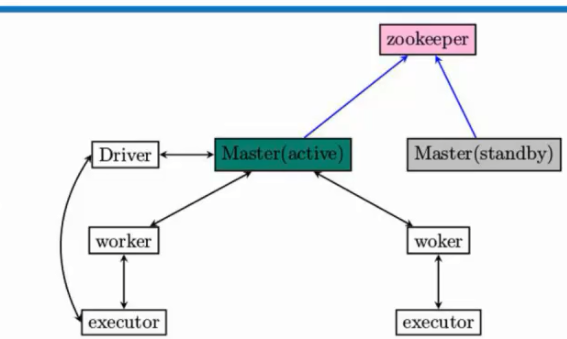实验环境:
zookeeper-3.4.6
Spark:1.6.0
简介:
本篇博客将从以下几点组织文章:
一:Spark 构建高可用HA架构
二:动手实战构建高可用HA
三:提交程序测试HA
一:Spark 构建高可用HA架构

Spark本身是Master和Slave,而这这里的
Master是指Spark资源调度和分配。负责整个集群的资源调度和分配。
Worker是管理单个节点的资源。
这里面的资源主要指:内存和CPU。
1. Master-Slave模型很容易出现单节点故障的问题。所以为了应用这个问题,解决办法是通过Zookeeper来解决,在实际开发的时候一般都是三台,一个active,两个standby,当一个active挂掉后,Zookeeper会根据自己的选举机制,从standby的Master选举出来一个作为leader。这个leader从standby模式变成active模式的话,做的最重要的事:是从Zookeeper中获取整个集群的状态信息,恢复整个集群的Worker,Driver,Application,这样才能接管整个集群的工作,而只有它成功完成之后,leader的Master才可以恢复成active的Master,才可以对外继续提供服务(作业的提交和资源的申请请求。),当active的master挂掉以后,standby的master变成active的master之前我们是不可以向集群提交新的程序。但是在Zookeeper切换期间,在这个时间集群的运行时正常的,例如,一个程序依然可以正常运行。因为程序在运行之前已经向Master申请资源了,Driver与我们所有worker分配的executors进行通信,这个过程一般不需要master参与,除非executor有故障。Master是粗粒度分配,粗粒度的好处当Master出故障以后,可以让Worker和executor交互完成计算。
2. Zookeper包含的内容有哪些:所有的Worker,Driver(代表了正在运行的程序),Application(应用程序)
如果Spark的部署方式选择Standalone,一个采用Master/Slaves的典型架构,那么Master是有SPOF(单点故障,Single Point of Failure)。Spark可以选用ZooKeeper来实现HA。
ZooKeeper提供了一个Leader Election机制,利用这个机制可以保证虽然集群存在多个Master但是只有一个是Active的,其他的都是Standby,当Active的Master出现故障时,另外的一个Standby Master会被选举出来。由于集群的信息,包括Worker, Driver和Application的信息都已经持久化到文件系统,因此在切换的过程中只会影响新Job的提交,对于正在进行的Job没有任何的影响。加入ZooKeeper的集群整体架构如下图所示。

1. Master的重启策略
Master在启动时,会根据启动参数来决定不同的Master故障重启策略:
- ZOOKEEPER实现HA
- FILESYSTEM:实现Master无数据丢失重启,集群的运行时数据会保存到本地/网络文件系统上
- 丢弃所有原来的数据重启
Master::preStart()可以看出这三种不同逻辑的实现。
-
override def preStart() {
-
logInfo("Starting Spark master at " + masterUrl)
-
...
-
-
-
persistenceEngine = RECOVERY_MODE match {
-
case "ZOOKEEPER" =>
-
logInfo("Persisting recovery state to ZooKeeper")
-
new ZooKeeperPersistenceEngine(SerializationExtension(context.system), conf)
-
case "FILESYSTEM" =>
-
logInfo("Persisting recovery state to directory: " + RECOVERY_DIR)
-
new FileSystemPersistenceEngine(RECOVERY_DIR, SerializationExtension(context.system))
-
case _ =>
-
new BlackHolePersistenceEngine()
-
}
-
-
leaderElectionAgent = RECOVERY_MODE match {
-
case "ZOOKEEPER" =>
-
context.actorOf(Props(classOf[ZooKeeperLeaderElectionAgent], self, masterUrl, conf))
-
case _ =>
-
context.actorOf(Props(classOf[MonarchyLeaderAgent], self))
-
}
-
}
RECOVERY_MODE是一个字符串,可以从spark-env.sh中去设置。
-
val RECOVERY_MODE = conf.get("spark.deploy.recoveryMode", "NONE")
如果不设置spark.deploy.recoveryMode的话,那么集群的所有运行数据在Master重启是都会丢失,这个结论是从BlackHolePersistenceEngine的实现得出的。
-
private[spark] class BlackHolePersistenceEngine extends PersistenceEngine {
-
override def addApplication(app: ApplicationInfo) {}
-
override def removeApplication(app: ApplicationInfo) {}
-
override def addWorker(worker: WorkerInfo) {}
-
override def removeWorker(worker: WorkerInfo) {}
-
override def addDriver(driver: DriverInfo) {}
-
override def removeDriver(driver: DriverInfo) {}
-
-
override def readPersistedData() = (Nil, Nil, Nil)
-
}
它把所有的接口实现为空。PersistenceEngine是一个trait。作为对比,可以看一下ZooKeeper的实现。
-
class ZooKeeperPersistenceEngine(serialization: Serialization, conf: SparkConf)
-
extends PersistenceEngine
-
with Logging
-
{
-
val WORKING_DIR = conf.get("spark.deploy.zookeeper.dir", "/spark") + "/master_status"
-
val zk: CuratorFramework = SparkCuratorUtil.newClient(conf)
-
-
SparkCuratorUtil.mkdir(zk, WORKING_DIR)
-
-
override def addApplication(app: ApplicationInfo) {
-
serializeIntoFile(WORKING_DIR + "/app_" + app.id, app)
-
}
-
-
override def removeApplication(app: ApplicationInfo) {
-
zk.delete().forPath(WORKING_DIR + "/app_" + app.id)
-
}
Spark使用的并不是ZooKeeper的API,而是使用的org.apache.curator.framework.CuratorFramework 和 org.apache.curator.framework.recipes.leader.{LeaderLatchListener, LeaderLatch} 。Curator在ZooKeeper上做了一层很友好的封装。
2. 集群启动参数的配置
简单总结一下参数的设置,通过上述代码的分析,我们知道为了使用ZooKeeper至少应该设置一下参数(实际上,仅仅需要设置这些参数。通过设置spark-env.sh:
-
spark.deploy.recoveryMode=ZOOKEEPER
-
spark.deploy.zookeeper.url=zk_server_1:2181,zk_server_2:2181
-
spark.deploy.zookeeper.dir=/dir
-
-
export SPARK_DAEMON_JAVA_OPTS="-Dspark.deploy.recoveryMode=ZOOKEEPER "
-
export SPARK_DAEMON_JAVA_OPTS="${SPARK_DAEMON_JAVA_OPTS} -Dspark.deploy.zookeeper.url=zk_server1:2181,zk_server_2:2181"
各个参数的意义:
参数
|
默认值
|
含义
|
spark.deploy.recoveryMode
|
NONE
|
恢复模式(Master重新启动的模式),有三种:1, ZooKeeper, 2, FileSystem, 3 NONE
|
spark.deploy.zookeeper.url
|
|
ZooKeeper的Server地址
|
spark.deploy.zookeeper.dir
|
/spark
|
ZooKeeper 保存集群元数据信息的文件目录,包括Worker,Driver和Application。
|
3. CuratorFramework简介
CuratorFramework极大的简化了ZooKeeper的使用,它提供了high-level的API,并且基于ZooKeeper添加了很多特性,包括
- 自动连接管理:连接到ZooKeeper的Client有可能会连接中断,Curator处理了这种情况,对于Client来说自动重连是透明的。
- 简洁的API:简化了原生态的ZooKeeper的方法,事件等;提供了一个简单易用的接口。
- Recipe的实现(更多介绍请点击Recipes):
- Leader的选择
- 共享锁
- 缓存和监控
- 分布式的队列
- 分布式的优先队列
CuratorFrameworks通过CuratorFrameworkFactory来创建线程安全的ZooKeeper的实例。
CuratorFrameworkFactory.newClient()提供了一个简单的方式来创建ZooKeeper的实例,可以传入不同的参数来对实例进行完全的控制。获取实例后,必须通过start()来启动这个实例,在结束时,需要调用close()。
-
-
-
-
-
-
-
-
-
-
-
public static CuratorFramework newClient(String connectString, int sessionTimeoutMs, int connectionTimeoutMs, RetryPolicy retryPolicy)
-
{
-
return builder().
-
connectString(connectString).
-
sessionTimeoutMs(sessionTimeoutMs).
-
connectionTimeoutMs(connectionTimeoutMs).
-
retryPolicy(retryPolicy).
-
build();
-
}
需要关注的还有两个Recipe:org.apache.curator.framework.recipes.leader.{LeaderLatchListener, LeaderLatch}。
首先看一下LeaderlatchListener,它在LeaderLatch状态变化的时候被通知:
- 在该节点被选为Leader的时候,接口isLeader()会被调用
- 在节点被剥夺Leader的时候,接口notLeader()会被调用
由于通知是异步的,因此有可能在接口被调用的时候,这个状态是准确的,需要确认一下LeaderLatch的hasLeadership()是否的确是true/false。这一点在接下来Spark的实现中可以得到体现。
-
-
-
-
-
-
-
-
-
public interface LeaderLatchListener
-
{
-
-
-
-
-
-
-
public void isLeader();
-
-
-
-
-
-
-
-
public void notLeader();
-
}
LeaderLatch负责在众多连接到ZooKeeper Cluster的竞争者中选择一个Leader。Leader的选择机制可以看ZooKeeper的具体实现,LeaderLatch这是完成了很好的封装。我们只需要要知道在初始化它的实例后,需要通过
-
public class LeaderLatch implements Closeable
-
{
-
private final Logger log = LoggerFactory.getLogger(getClass());
-
private final CuratorFramework client;
-
private final String latchPath;
-
private final String id;
-
private final AtomicReference<State> state = new AtomicReference<State>(State.LATENT);
-
private final AtomicBoolean hasLeadership = new AtomicBoolean(false);
-
private final AtomicReference<String> ourPath = new AtomicReference<String>();
-
private final ListenerContainer<LeaderLatchListener> listeners = new ListenerContainer<LeaderLatchListener>();
-
private final CloseMode closeMode;
-
private final AtomicReference<Future<?>> startTask = new AtomicReference<Future<?>>();
-
.
-
.
-
.
-
-
-
-
-
-
-
-
-
-
-
-
public void addListener(LeaderLatchListener listener)
-
{
-
listeners.addListener(listener);
-
}
通过addListener可以将我们实现的Listener添加到LeaderLatch。在Listener里,我们在两个接口里实现了被选为Leader或者被剥夺Leader角色时的逻辑即可。
4. ZooKeeperLeaderElectionAgent的实现
实际上因为有Curator的存在,Spark实现Master的HA就变得非常简单了,ZooKeeperLeaderElectionAgent实现了接口LeaderLatchListener,在isLeader()确认所属的Master被选为Leader后,向Master发送消息ElectedLeader,Master会将自己的状态改为ALIVE。当noLeader()被调用时,它会向Master发送消息RevokedLeadership时,Master会关闭。
-
private[spark] class ZooKeeperLeaderElectionAgent(val masterActor: ActorRef,
-
masterUrl: String, conf: SparkConf)
-
extends LeaderElectionAgent with LeaderLatchListener with Logging {
-
val WORKING_DIR = conf.get("spark.deploy.zookeeper.dir", "/spark") + "/leader_election"
-
-
private var zk: CuratorFramework = _
-
-
private var leaderLatch: LeaderLatch = _
-
private var status = LeadershipStatus.NOT_LEADER
-
-
override def preStart() {
-
-
logInfo("Starting ZooKeeper LeaderElection agent")
-
zk = SparkCuratorUtil.newClient(conf)
-
leaderLatch = new LeaderLatch(zk, WORKING_DIR)
-
leaderLatch.addListener(this)
-
-
leaderLatch.start()
-
}
在prestart中,启动了leaderLatch来处理选举ZK中的Leader。就如在上节分析的,主要的逻辑在isLeader和noLeader中。
-
override def isLeader() {
-
synchronized {
-
-
-
if (!leaderLatch.hasLeadership) {
-
return
-
}
-
-
logInfo("We have gained leadership")
-
updateLeadershipStatus(true)
-
}
-
}
-
-
override def notLeader() {
-
synchronized {
-
-
if (leaderLatch.hasLeadership) {
-
return
-
}
-
-
logInfo("We have lost leadership")
-
updateLeadershipStatus(false)
-
}
-
}
updateLeadershipStatus的逻辑很简单,就是向Master发送消息。
-
def updateLeadershipStatus(isLeader: Boolean) {
-
if (isLeader && status == LeadershipStatus.NOT_LEADER) {
-
status = LeadershipStatus.LEADER
-
masterActor ! ElectedLeader
-
} else if (!isLeader && status == LeadershipStatus.LEADER) {
-
status = LeadershipStatus.NOT_LEADER
-
masterActor ! RevokedLeadership
-
}
-
}
5. 设计理念
为了解决Standalone模式下的Master的SPOF,Spark采用了ZooKeeper提供的选举功能。Spark并没有采用ZooKeeper原生的Java API,而是采用了Curator,一个对ZooKeeper进行了封装的框架。采用了Curator后,Spark不用管理与ZooKeeper的连接,这些对于Spark来说都是透明的。Spark仅仅使用了100行代码,就实现了Master的HA。当然了,Spark是站在的巨人的肩膀上。谁又会去重复发明轮子呢?

